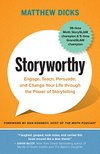Storyworthy: Engage, Teach, Persuade, and Change Your Life through the Power of Storytelling
amazon.com
Saved by Ramon Haindl and
Storyworthy: Engage, Teach, Persuade, and Change Your Life through the Power of Storytelling

Saved by Ramon Haindl and
Find the moment in your story that everyone has been waiting for, then flip that Hourglass and let the sand run.
Speak as if you were speaking to friends.
Early laughter puts everyone at ease and makes the next few minutes supremely easier.
Steve stopped me as I walked back to my seat and said, “You know what your problem is?” I had never spoken to my hero before, so I was flummoxed. “No?” I managed. “You’re not nervous up there, so you have to have a great story every time.”
Five Permissible Lies of Storytelling Lie #1: Omission Every story contains omissions. If you were to tell every single thing in the story, it would never end. We all omit elements from our stories, but great storytellers do this strategically and for a variety of reasons.
It’s a human need to be told stories. The more we’re governed by idiots and have no control over our destinies, the more we need to tell stories to each other about who we are, why we are, where we come from, and what might be possible. — Alan Rickman
speak less. Make time your ally.
an Hourglass. It’s time to slow things down. Grind them to a halt when possible. When you know the audience is hanging on your every word, let them hang. Drag out the wait as long as possible.
The most common response is “I thought you were going to find a McDonald’s and work at it for a few hours to earn the money you needed.” “Yes,” I say. “Because this is how McDonald’s restaurants work.